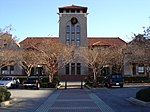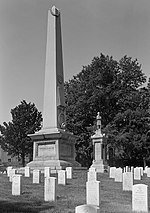Brooklyn–South Square Historic District
Brooklyn–South Square Historic District is a national historic district located at Salisbury, Rowan County, North Carolina. The district encompasses 65 contributing buildings in predominantly residential section of Salisbury. It largely developed between about 1875 and 1925, and includes notable examples of Federal, Greek Revival, and Late Victorian style architecture. Notable buildings include the Woodson-Overcash House (c. 1840), Blackmer-Propst House (c. 1856), Mowery-Peeler House (c. 1880), Keen-Bastian House (c. 1895), William Trott House (1905), J. W. Glover House (1920s), Cross-Crowell-Rufty Store (1920s), Burges-Lyerly-Fifty/Fifty Store (1920s), and the former St. Peter's Episcopal Church.It was listed on the National Register of Historic Places in 1985.
Excerpt from the Wikipedia article Brooklyn–South Square Historic District (License: CC BY-SA 3.0, Authors).Brooklyn–South Square Historic District
South Long Street, Salisbury
Geographical coordinates (GPS) Address Nearby Places Show on map
Geographical coordinates (GPS)
| Latitude | Longitude |
|---|---|
| N 35.663611111111 ° | E -80.468888888889 ° |
Address
South Long Street 268
28144 Salisbury
North Carolina, United States
Open on Google Maps










